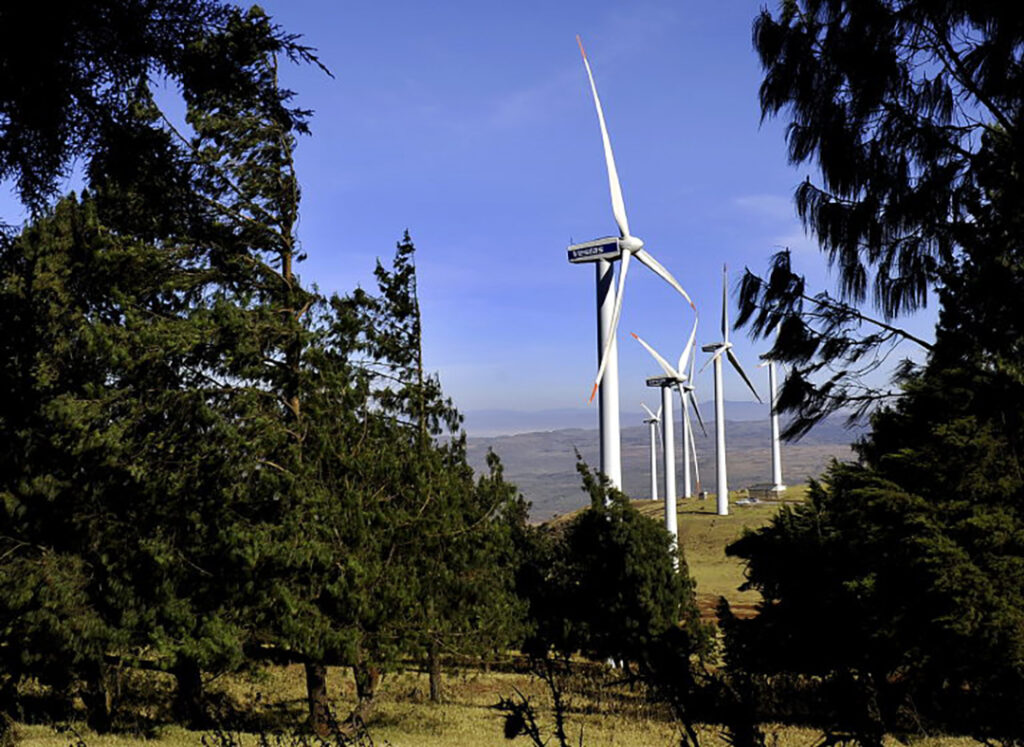Driving into Ngong, a town located about 30 km southwest of Kenya’s capital, Nairobi, you will see giant wind turbines jutting into the sky from a scenic hill dotted with trees, a short distance away. Navigate your way along the dirt road that winds uphill, leading to a protected forested area managed by the Kenya Forest Service, and security guards will politely wave you down at the main entrance. The uniformed guards will only allow you through the gate after paying Sh232 ($1.72).
Muted whooshing sounds churned by imposing wind-power generating turbines welcome those who do ascend to Kenya’s 25.5MW Ngong Hills wind farm, the third-largest wind power project in the country.
Kenya is also home to the Lake Turkana wind power plant in Marsabit County, which is considered the largest wind farm in Africa with an installed capacity of 310MW. Another wind farm, Kipeto, the second-largest in the country, produces 100MW.
With each gush and gust of the wind that pushes the turbines to rotate, the three plants, connected to the national grid, cumulatively produce 436.1 MW. According to data from Kenya’s Energy and Petroleum Regulatory Authority (EPRA), this is roughly 17.22 % of the country’s energy needs. The country’s president, William Ruto, has set an ambitious goal of transitioning to 100% clean energy by 2030. Having taken his oath of office in September last year, Ruto made a bold call to African countries to end their over-reliance on fossil fuels while re-affirming his government’s commitment to go fully green in seven years.
In his inauguration address, Ruto stated that his administration’s central concern would be climate change, cautioning that the entire country – and the continent – faced severe consequences from the climate emergency. But Africa, he said, had the potential to lead the world in phasing out reliance on coal, oil, and gas, adding, “We must act urgently to keep global heating levels below 1.5 Celsius, help those in need, and end addiction to fossil fuels.” Ruto, who is also the coordinator of the Committee of African Heads of State and Government on Climate Change (CAHOSCC), called on all countries in the continent to join Kenya in the endeavour.
Nine months after taking office, the president has been relentless in his campaign for clean energy, using every platform in Kenya and abroad to rally the continent – and the world – to go green. Addressing the COP27 climate summit in Egypt last November, he said: “Developed nations must switch from carbon-heavy energy and direct their industrial investments to Kenya and other African countries already producing clean energy. That way, we will save the globe from climate change.”
A month later, at the US-Africa Summit in Washington, DC, Ruto said: “We believe the full potential of our energy from wind and geothermal remains untapped due to insufficient investment in distribution and storage. Kenya will collaborate with the US government to exploit that potential and contribute to making Kenya a clean, green energy destination.”
While some might misunderstand the president’s comments as a sign the country is lagging in embracing renewables, nothing could be further from the truth. The latest survey by the Kenya National Bureau of Statistics (KNBS) shows that the country, with a population of 50 million people, is already making significant progress towards achieving the ambitious 100% clean energy goal.
According to the KNBS Economic Survey 2023 report, the bulk of Kenya’s electricity mix last year was generated from zero-carbon sources, with the energy coming primarily from geothermal power, hydro, and wind energy.
“During the period, local electricity generation from renewable sources accounted for 87.5%,” the report, which was released in May this year, said. “Geothermal generation continues to be the largest source of electricity, accounting for 43.6% of total electricity generation in 2022.”
Geothermal, mainly produced at Hell’s Gate in the Rift Valley, around 90 km northwest of Nairobi, was followed by hydro (24.0%) and wind (16.9%), while the rest was from non-thermal sources.
Kenyan Energy and Petroleum Cabinet Secretary Davis Chirchir, during a recent state visit by German Chancellor Olaf Scholz, said the county was the leading geothermal power producer on the continent.
Speaking at the same meeting, Kenya Electricity Generating Company (KenGen) acting CEO Abraham Serem said the organisation was focused on maximising its potential in green energy generation.
“We are committed to developing and implementing green energy projects that will help us meet the country’s growing efforts towards sustainability while being part of the push towards minimising our carbon footprint,” said Serem.
Chirchir’s remarks are buttressed by a report by the International Renewable Energy Agency’s Renewable Capacity Statistics 2023, which ranks Kenya as Africa’s leading country in geothermal capacity. The country is also ranked 7th globally, with 949MW channelled to the national grid; the US tops the list (2,653MW), followed by Indonesia (2,343MW), the Philippines (1,932MW), Turkey (1,691MW), New Zealand (1,273MW), and Mexico (1,059). Italy (772MW), Iceland (757MW), and Japan (431MW) round out the top 10.
Ali Mohamed, Kenya’s Special Envoy for Climate Change in the executive office of the president, believes the country has done significantly well in embracing renewable energy.
“As a nation, we have already demonstrated to the world that it is possible to fully transition to clean energy,” he told Africa in Fact. “We have done that through a combination of renewable-friendly policies, natural abundance, and tailored solutions for different needs. Compared to our peers in the region, Kenya is a regional and continental leader in green energy, with nearly 90% of our energy mix coming from renewable sources. Very few countries in Africa and the world can boast of that.”
The office of Climate Change Secretary is a recent addition since Ruto entered office, and environmentalists have hailed Mohamed’s appointment as a demonstration of the president’s readiness to tackle climate change.
“The president understands the seriousness of climate change and its threats to development,” Mohamed said. “He knows that African countries are most exposed, and that’s why he is part of those seeking solutions to the challenge of global warming.” Kenya, meanwhile, will host the Africa Climate Summit from 4-6 September this year.
Key players in Kenya’s energy sector agree with Mohamed’s sentiments but point out that Kenya is yet to fully tap its vast renewable energy potential. Wangari Muchiri, the Africa Director for the Global Wind Energy Council, lauded Ruto for spearheading Kenya’s ambitious green growth agenda but reiterated that more was still to be done.
“With an average wind speed of 7.5 m/s at 100 m above ground level, Kenya has great untapped potential in wind energy waiting to be harnessed,” she told Africa in Fact. “The country has the potential to produce up to 242,600MW of electricity from wind alone.”
Raphael Chesori, the president of the African Young Generation in Nuclear (AYGN), said the country needed to look beyond wind, solar, and geothermal if it wanted to meet its goal of going green by 2030. “There is no way we can claim to champion a clean energy transition as a country while we ignore nuclear,” he said. “It is a renewable energy resource that Kenya and other African countries cannot ignore.”
The Kenya News Agency published a report last October quoting Justus Wabuyabo, the director of legal and regulatory services for Kenya’s Nuclear Power and Energy Agency (NuPEA), saying a nuclear power plant of 1,000MW would be commissioned by 2038 and that NuPEA had signed an MoU with China, Russia, South Korea and Slovakia to train personnel for this purpose.
However, Chesori, an International Atomic Energy Agency PhD Fellow at the Institute of Nuclear Chemistry and Technology in Warsaw, Poland, lamented the little progress made to date. “We cannot afford to overlook the potential of nuclear energy in the continent,” he said. “It is part of the solution. Developed countries like France and Japan largely rely on nuclear energy to generate power and we can do the same.”

Daniel Psirmoi is a senior parliamentary and political writer for The Standard Newspaper based in Nairobi, Kenya. He is part of team that covers the National Assembly and the Senate with his day to day job involving keeping tabs with what the legislators are up to and developing news stories and features. He also has interests in governance and sustainable community development.



